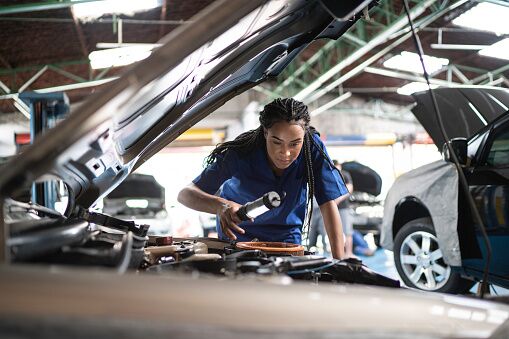All Categories
Featured

Maintaining your vehicle's tires is necessary to make sure a smooth, secure, and efficient driving experience. 2 vital solutions that are commonly overlooked yet have a considerable effect on tire longevity and performance are tire rotation and placement. These solutions help maintain your automobile running effectively and stop uneven tire wear that can influence both security and gas economic climate. Allow's dive right into what tire turning and positioning are and why they are essential for your auto.
What Is Tire Turning? Tire rotation is the procedure of relocating your tires from one placement to another to guarantee they put on equally. Considering that your vehicle's tires work at different rates relying on their setting (front tires versus rear tires), rotating them consistently aids to disperse the wear equally, bring about a much longer lifespan for your tires.
Tires on the front axle often tend to put on more promptly than those on the rear axle, especially in front-wheel-drive vehicles, where the front tires manage both steering and power. On the other hand, back tires might put on erratically depending upon the car's weight distribution and driving problems. By turning your tires every 6,000 to 8,000 miles (or as recommended by the maker), you'll make certain a more balanced wear pattern.
What Is Tire Positioning? Tire alignment, also referred to as wheel positioning, refers to changing the angles of your auto's wheels to the supplier's specifications. Appropriate alignment makes certain that your tires are pointing in the best instructions, and it aids take full advantage of tire life and improve vehicle handling. There are 3 main aspects of alignment: camber, wheel, and toe.
Camber refers to the tilt of the tires from the front of the automobile. If your tires are slanted way too much inward or outside, it can cause unequal wear. Caster describes the angle of the steering axis when seen from the side of the auto. This influences the security of the steering, specifically when driving right. Toe describes the angle at which the tires aim internal or outside when seen from above. This influences exactly how your car tracks when traveling. An appropriate alignment ensures that all four tires are pointing right ahead and are tilted appropriately. Misalignment can result from striking pits, visuals, or merely from the wear of suspension elements with time.
Why Tire Rotation and Placement Matter. Extended Tire Life. Both tire turning and alignment aid protect against irregular tire wear. When your tires wear evenly, they last longer, which can conserve you cash in the future by decreasing the need for premature substitutes.
Improved Safety. Appropriate tire rotation and placement boost automobile security and handling. Misaligned tires or unevenly used tires can adversely affect your ability to guide and quit your vehicle, particularly in emergency scenarios. Routine upkeep guarantees your tires do optimally, supplying a safer driving experience.
Much Better Gas Effectiveness. If your tires are not straightened appropriately, they may drag versus the roadway surface, creating resistance. This additional rubbing can decrease fuel performance, triggering your automobile to eat more gas. Normal tire positioning guarantees that your car relocates effectively, improving gas mileage.
Boosted Comfort. Misalignment or unevenly used tires can bring about a rougher ride, as your car may draw away or cause resonances. By keeping your tires revolved and lined up, you'll delight in a smoother and much more comfy driving experience.
Signs That Your Tires Required Rotation or Positioning. It's necessary to remain sharp for any indicators that your tires require turning or alignment. Watch out for these typical indicators:
Unequal Tire Wear: If you discover that one tire is considerably extra used than the others, it may be time for a rotation or placement. Guiding Pull: If your auto draws away while driving right, this could show misalignment. Vibrations: If you feel vibrations in the steering wheel or the auto itself, it could be an indication of imbalance or unequal tire wear. Squealing Tires: Unusual tire noise might also indicate improper positioning or the requirement for a tire rotation. How Usually Should You Rotate and Align Your Tires? Tire turning must usually be done every 6,000 to 8,000 miles or as specified in your vehicle's proprietor's handbook. It's a great concept to rotate your tires throughout every oil modification, as this will aid you remain on top of routine upkeep.
As for alignment, it does not require as regular service. Commonly, alignment should be inspected a minimum of when a year or whenever you observe concerns like drawing away or vibration. You may likewise need positioning if you've hit a big fracture or curb, which can toss your wheels out of positioning.
Conclusion: Keep Your Tires in Top Forming. Tire rotation and positioning are important services that maintain your automobile running efficiently, safely, and efficiently. By putting in the time to have your tires turned and lined up on a regular basis, you're purchasing your auto's performance and durability, while likewise boosting your safety and security when traveling. Keep aggressive with tire maintenance, and your cars and truck will thank you with far better fuel economic climate, boosted handling, and prolonged tire life.
Latest Posts
Advanced Eye Center South - Eye Care Center: Premier Eye Care in Dothan, AL.
Detecting and Fixing Electrical Concerns
A Journey With Time at the Deauville Inn